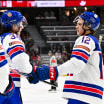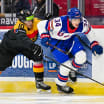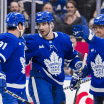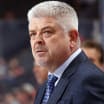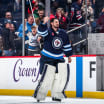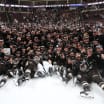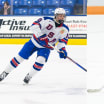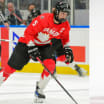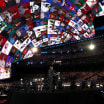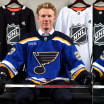As part of NHL.com's 30 Teams in 30 Days, the fantasy hockey staff is breaking down each team's landscape. From the most valuable assets to underrated options, impact prospects and more, this guide should help fantasy owners prioritize players for drafts this fall.
Detroit Red Wings fantasy outlook
Dylan Larkin set for expanded role; Frans Nielsen can spark Tomas Tatar, Gustav Nyquist
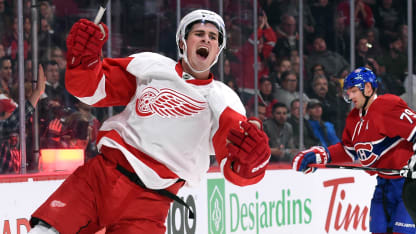
© Francois Lacasse/Getty Images
Starting at the top: Dylan Larkin, C/LW
This is the first time in more than a decade that Pavel Datsyuk and Henrik Zetterberg have not been the Red Wings' top-ranked fantasy forwards entering a season. Datsyuk left the NHL to play in Russia, and Zetterberg is more of a bounce-back candidate than a fantasy certainty at this stage of his career. Larkin, second among rookies with 40 even-strength points last season (the Chicago Blackhawks' Artemi Panarin had 53), should see greater usage in all situations this season. Center Brad Richards retired, so the Red Wings can't afford to have Larkin take a step back in his second season in the League. Larkin, 20, is ranked 119th in the NHL.com top 200 and was a balanced scorer (23 goals, 22 assists) with a strong plus/minus (plus-11) and a heavy shot-on-goal volume (221). He could switch to center and should see more ice time on the power play (2:02 per game in 2015-16), which could lead to more production (five power-play points) and a jump into the 60-point realm. He should be targeted as early as the ninth or 10th round of a 12-team draft and warrants even higher regard in a keeper draft.
Red Wings 30 in 30: Season outlook | Burning questions, reasons for optimism | Top prospects | Fantasy: Top 200
Undervalued: Frans Nielsen, C
Among the Red Wings' biggest questions is whether Tomas Tatar or Gustav Nyquist can return to form as a high-end goal-scorer. Signing Nielsen in free agency helps the bounce-back causes for each; he could play between Tatar and Nyquist on the second line. Last season there was a lot of line shuffling by coach Jeff Blashill, and Tatar and Nyquist found themselves centered mostly by Riley Sheahan. Nielsen, who finished 116th in Yahoo's performance-based rankings with the New York Islanders last season, brings an impressive power-play track record (58 power-play points the past three seasons, tied for 25th among forwards) to the Red Wings. He's also coming off a career high 181 shots on goal and is capable of 50 or more points in the right spot. Consider him a draft bargain if available in the 14th round or later in a 12-team league.
Overvalued: Mike Green, D
Green's power-play points increased last season (20 in 74 games) compared to 2014-15, his final season with the Washington Capitals (17 in 72 games). But his fantasy profile lacked coverage last season. He was a minus-6, had fewer than 40 penalty minutes (38) for the second straight season, and his 124 shots on goal were his lowest in a season when he played 70 or more games since his rookie season (2006-07). Fantasy owners should be aware that Green's seasons of 70 points and 200 shots on goal likely are over, and there are plenty of players worth a fourth defenseman or bench spot on your roster who should be available ahead of Green. Taking him earlier than his NHL.com rank (No. 186) may lead to disappointment, especially given he has played 80 or more games once in his 11-season career.
Sleeper: Andreas Athanasiou, C
Athanasiou, a depth forward last season, had nine goals on 53 shots on goal in 37 regular-season games and scored the game-winning goal in Game 3 of the Eastern Conference First Round against the Tampa Bay Lightning. His average ice time was minimal (9:01 per game), but he ranked third in the NHL in goals per 60 minutes in the regular season among players with at least 30 games, behind Maurice Richard Trophy winner Alex Ovechkin (50 goals, Washington Capitals) and Art Ross Trophy winner Patrick Kane (46, Chicago Blackhawks). Regardless of how Athanasiou might get there, by performance or as an injury fill-in, he has a chance to do some serious damage if he gets a top-six chance. The 22-year-old is the definition of a deep sleeper; don't take him high enough to regret it in case he doesn't get quality ice time, but he could lead the injection of youth in the post-Datsyuk era.
Bounce-back: Henrik Zetterberg, C
Like Tatar and Nyquist, Zetterberg no longer is worth drafting inside the top 100. That said, there's some sneaky upside to him if he falls to the 10th round or later in a 12-team league. Although Zetterberg had his worst points-per-game average (0.61) since his rookie season in 2002-03 (0.56), he had 22 power-play points and 214 shots on goal in 82 games. Zetterberg and Datsyuk played on the same line from time to time in recent seasons, but the times they were together represented the successful core of the past but also one that was aging. As the Red Wings turn the page, Zetterberg gets a clean slate and chance to feed off young talent. A shooting percentage correction (6.1 last season, third-lowest among forwards with at least 200 shots on goal) and the right linemates could be what Zetterberg needs to return to 55-60 points and outperform his average draft position.
Impact prospect: Evgeny Svechnikov, LW
The early stages of Svechnikov's development in North America have been impressive. He has averaged more than one point per game in each of the two seasons with Cape Breton of the Quebec Major Junior Hockey League. After he had four goals and 11 assists in 13 games in the QMJHL playoffs, he played two games for Grand Rapids of the American Hockey League in the Calder Cup Playoffs and had one assist, three shots on goal. Svechnikov, the 19th pick of the 2015 NHL Draft, is 19 years old, but his raw offensive potential could be intriguing depending on how he fares in training camp. The Red Wings also could keep him in the AHL to develop and summon him if injuries mount.
Goalie outlook
This is one of the toughest time-shares to judge at the moment, considering Petr Mrazek had a breakout season but a shaky finish, enabling Jimmy Howard to steal playing time late in the season and during the Stanley Cup Playoffs. If either is worth drafting in the middle rounds, it's clearly Mrazek, 24, who's younger than Howard, 32, and was on the better end of the start split (49-33). Mrazek had 27 wins, a 2.33 goals-against average, .921 save percentage and four shutouts, but fell apart down the stretch; in his final 16 regular-season games he was 6-6-1 with a 3.34 GAA and .886 save percentage. Mrazek is 19th among goalies in NHL.com's rankings and Howard is 30th, a reversal from where they went on average in drafts last season (Howard: 126.4, Mrazek: 170.3). Mrazek is the Red Wings' goalie of the future, but Howard is under contract and around for support when needed. The Red Wings offense ranked 23rd in goals per game (2.55) with Datsyuk, so it's fair to question the potential offensive support for either goalie. Rarely can a goalie be a sleeper two straight seasons, but Mrazek should be available outside the top 15 at his position again. If you believe in the Red Wings' youth movement and that Mrazek's struggles were a blip on the radar, then reach for him as early as the eighth round in a 12-team draft to be the second goalie on your roster.
